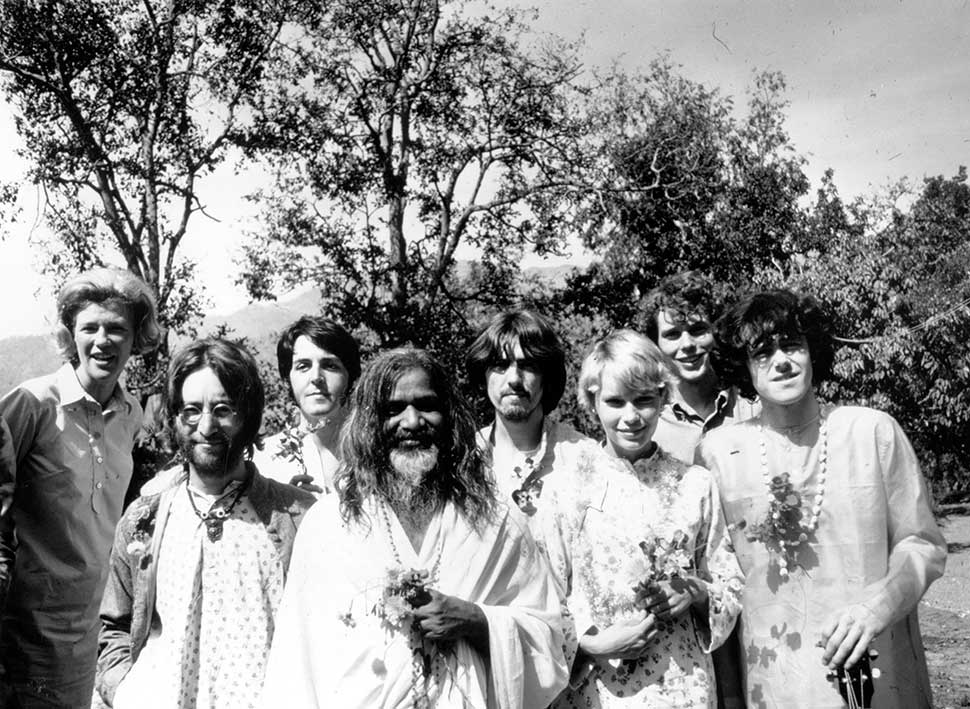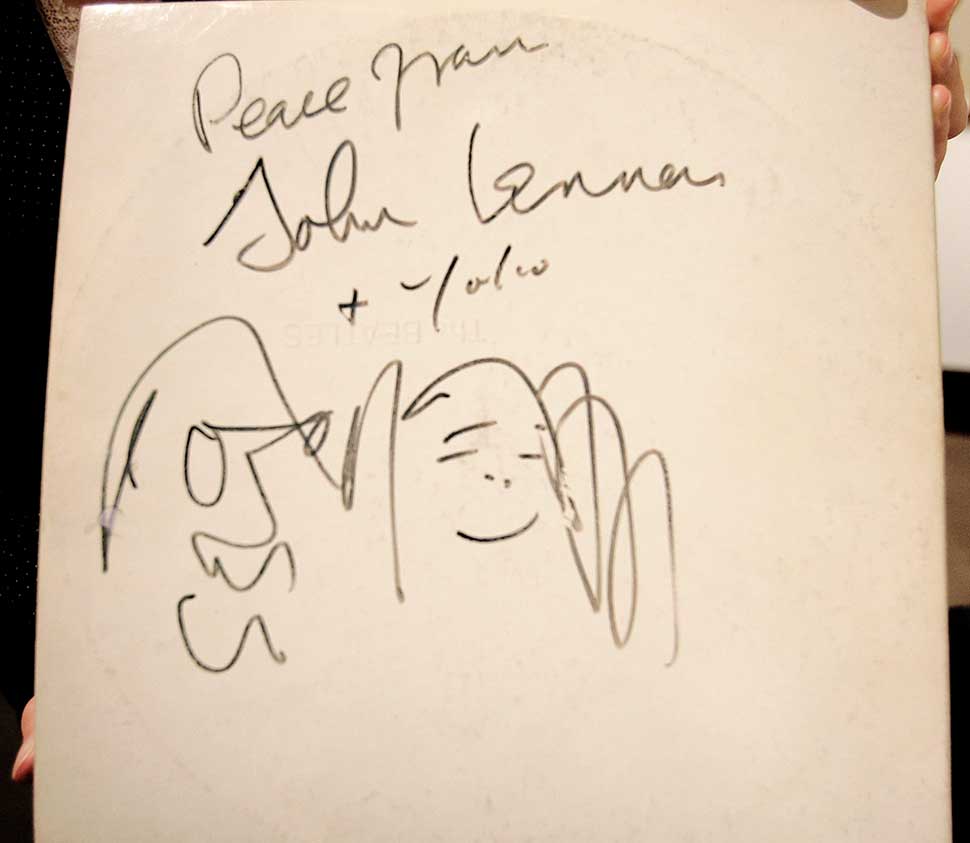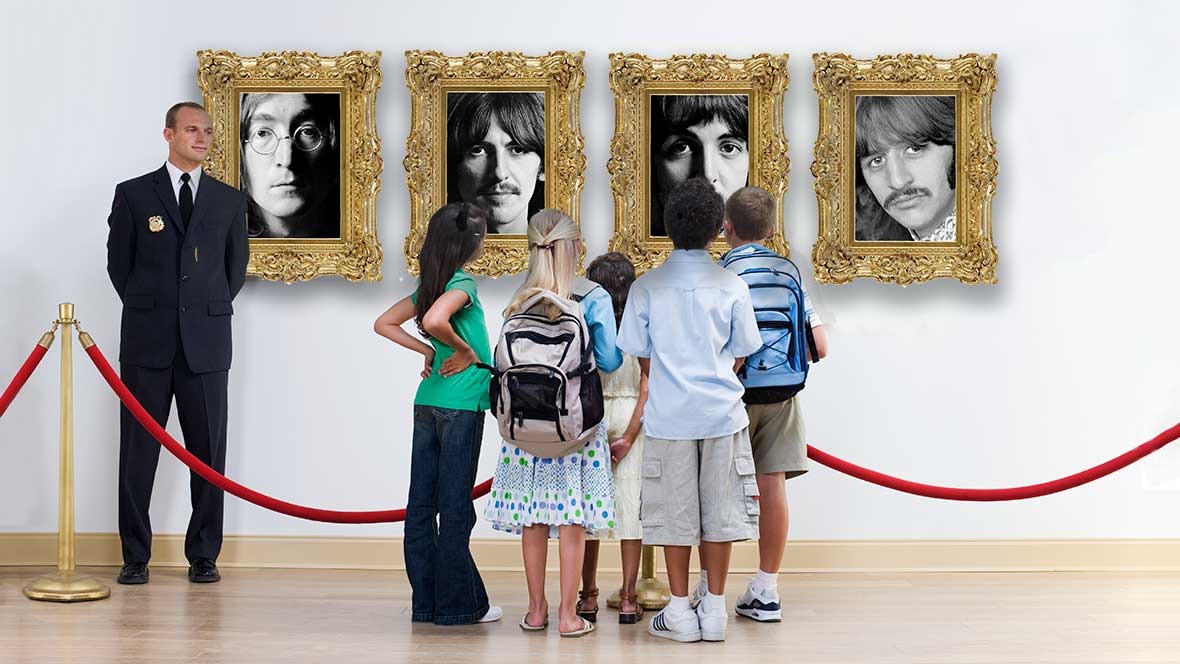Released on the fifth anniversary of the assassination of US President John F . Kennedy, The Beatles' White Album saw John Lennon, Paul McCartney, George Harrison and Ringo Starr create a a blueprint for the future of rock music as they began to splinter as a group.
With Brian Epstein dead, Lennon self-medicating with LSD, Yoko Ono's presence a distraction and Starr temporarily leaving the band, it was an album where the Beatles' washed their dirty laundry in the most public manner possible.
These are the 50 things about The Beatles' White Album you need to know.

1. Referring to The Beatles’ ninth LP as The White Album is like referring to 1991’s Metallica as The Black Album – technically incorrect, but universally understood. It wasn’t meant to be called The Beatles, either, but the band opted for simplicity after their working title, A Doll’s House, was gazumped by Family’s Music In A Doll’s House.
2. Sleeve designer Richard Hamilton suggested tainting the virginal cover with a coffee mug ring, but was told this was “too flippant”. He earned his fee with a stamped serial number, unique to each copy and creating, he felt, “the ironic situation of a numbered edition of something like five million copies”.
3. The bulk of The White Album was conceived in Rishikesh, India, as The Beatles sought enlightenment in the meditation classes of famed spiritualist, Maharishi Mahesh Yogi. Apparently less committed than Guru Harrison, Lennon and McCartney “met clandestinely in each other’s rooms” to plot the next album.
4. In marked contrast to the studio experimentation of Sgt. Pepper, the only instrument available to The Beatles at Rishikesh was the acoustic guitar. Reportedly, their skills were rudimentary; it took tutorials from Scottish folkie and fellow guest Donovan for Lennon to master the fingerpicking style used in Julia.
5. Initially described by Starr as “like Butlins”, the mood at Rishikesh soured when the Maharishi was accused of assaulting Hollywood starlet Mia Farrow (denied by McCartney and Harrison; Farrow is ambiguous about the incident in her book). “Why are you leaving?” the guru is said to have asked as The Beatles packed up. “If you’re so cosmic, you’ll know why,” came Lennon’s acerbic reply.

6. Returning from Rishikesh in staggered formation – Starr after two weeks, then McCartney, then Lennon and Harrison – the band met to demo White Album tracks at Harrison’s bungalow in Kinfauns, Surrey
7. Sexy Sadie was written upon Lennon’s departure as a snipe at the disparity between the Maharishi’s spiritual ideals and physical appetites. “I was leaving the Maharishi with a bad taste,” he told biographer David Sheff. “I just called him ‘Sexy Sadie’ instead of ‘Maharishi, what have you done…’” .
8.Until the pitched battles of Let It Be, The White Album stood as the lowest ebb in Beatles relations, with McCartney, Harrison and Starr fuming at the omnipresence of Lennon’s new love, Yoko Ono, and each member taking up a different corner of Abbey Road as his creative headquarters. Only 16 of the 30 songs feature all four Beatles – no wonder Lennon described The White Album as a collection of solo recordings, or “me with a backing band, Paul with a backing band…”
9. The bad vibes extended to the control room, with George Martin ditching his trademark diplomacy to question the cohesion and quality of material. “It was a marvellous album, but it was up and down,” the producer noted later. “There were some great ones and some not so great ones. They brought me a whole host of songs, all of which they wanted to record, and that was what happened with The White Album.”
10. The cracks in the Fabs’ façade couldn’t be entirely attributed to the so-called Wicked Witch of the East. Just as damaging to the band dynamic, according to Martin, was the death of manager, mentor and ego-pricker Brian Epstein. “Once Brian died [in 1967],” points out the producer, “things changed quite a bit and The Beatles tended to go off in their own directions. The White Album is a result of that.”
11. Debut album Please Please Me was knocked out in a 12-hour marathon at Abbey Road. Not so for The White Album – sessions lasted 137 days from the band’s first stab at Revolution 1 on May 30, 1968.
12. Frustrated and starved of sunlight, Martin booked himself a mid-term holiday in Greece, handing over to 22-year-old engineer Chris Thomas – and thus making The White Album the only Beatles LP to feature a second producer. “I’d just come back from holiday myself,” recalls Thomas. “And when I came in there was a little note on the desk that said: ‘Dear Chris, hope you had a nice holiday. I’m off on mine now. Make yourself available to The Beatles.’”
13. Continuing his trial-by-fire, Thomas was enlisted to play on three White Album tracks, contributing mellotron to The Continuing Story Of Bungalow Bill, electric piano to Savoy Truffle and, most notable, the harpsichord line in Piggies. No wonder he wasn’t fazed by producing Never Mind The Bollocks…
14. Starr doesn’t appear on The White Album tracklisting until Glass Onion; having taken exception to McCartney’s criticism of a drum fill on Back In The U.S.S.R., he walked out of the session at the end of August 1968, and missed the one for Dear Prudence into the bargain (McCartney took over on the drums for U.S.S.R. and Prudence). Starr spent his AWOL fortnight with Peter Sellers on his yacht in Piraeus. He was ultimately coerced back with an apologetic telegram from Lennon, returning to find his drumkit bedecked with red, white and blue flowers.
15. Not only did McCartney fill in on drums for Back In The U.S.S.R, he also plotted the concept. “I wrote it as a Beach Boys parody,” he told Playboy. “And Back In The USA was a Chuck Berry song, so it took off from there. I just liked the idea of Georgia girls and talking about places like the Ukraine as if they were California, you know? It was also hands across the water, because the kids like us out there, even though the bosses in the Kremlin may not.”
16. Dear Prudence is one of The White Album’s most overt references to Rishikesh, written by Lennon for Prudence Farrow, whose enthusiasm for meditation had left her “slightly barmy” and reluctant to leave her chalet. The lyric could not be more literal – ‘Dear Prudence, won’t you come out to play?’
17. The White Album was the first Beatles LP to be released on the band’s own Apple Records.
18. As well as being among The White Album’s most irritating moments, Ob-La-Di, Ob-La-Da was also a phrase used by Nigerian conga player Jimmy Scott, literally meaning ‘life goes on’. McCartney claimed the phrase was common among the Yoruba tribe and that Scott had simply passed it on to him. But furious to find his catchphrase hijacked, Scott sued McCartney and was later paid off.
19. The Continuing Story Of Bungalow Bill is another Rishikesh creation, inspired by Lennon’s disgust at the questionable actions of a British aristocrat named Richard A Cook III. “He was a guy in the meditation camp who took a break to go shoot a few tigers, then came back to commune with God,” explained Lennon.
20. If nothing else, Bungalow Bill is notable for featuring the only female lead vocal on a Beatles track. Playing the mother of the tiger-slaying protagonist, Yoko Ono chimes in with a shrill ‘but when he looks so fierce’ at 1.45.
21. McCartney’s atonal Wild Honey Pie made the cut because it was a favourite of Pattie Harrison. The public disagree: it tends to chart in surveys as the second-worst White Album track, after Revolution 9.
22. George Harrison had already attempted a backwards solo on While My Guitar Gently Weeps before he enlisted Eric Clapton – the first non-Beatle to play guitar on a Beatles album. “So Eric played it and it was really good,” Harrison recalled. “Then we listened to it back, and he said: ‘Ah, there’s a problem, it’s not Beatley enough.’ So we put it through the ADT [automatic double-track] to wobble it up a bit.”
23. Ringo had been working on Don’t Pass Me By for five years before he was cajoled into completing it for The White Album. Unloved among most Beatles fans, it proved an unlikely hit single in Sweden.
24. One of the biggest White Album fallouts between Lennon and McCartney was sparked by the latter recording Why Don’t We Do It In The Road? without the former, in a corridor of Abbey Road. Frustrated at his exclusion from Macca’s ode to rutting monkeys in Rishikesh – particularly as it was laid down on his 28th birthday – Lennon took revenge by recording Revolution 9 while the bassist was in New York.
25. Happiness Is A Warm Gun began as a headline that George Martin spotted in a firearms magazine and mentioned to Lennon, who declared it a “fantastic, insane thing to say”. Less insane was the origin of the phrase – a 1962 Peanuts cartoon anthology called Happiness Is A Warm Puppy.

26. In an isolated moment of bonhomie, The Beatles downed tools on September 18 to watch the first TV screening of 50s comedy film The Girl Can’t Help It. The star was Jayne Mansfield, but the reason for the band’s interest were the cameos of boyhood heroes like Little Richard and Gene Vincent. As the credits rolled, an inspired McCartney drafted 50s stomper Birthday, while Lennon scribbled the lyrics.
27. As teenagers, McCartney and Harrison had learnt Bach’s Bouree In E as a ‘show-off piece’, and the bassist mined the piece again as the inspiration for Blackbird. The twittering at 1.38 suggested the lyric was literal, though McCartney has since claimed he “had in mind a black woman, rather than a bird”.
28. The tremulous climax of Long, Long, Long was a happy accident, with the initial rattle at 2.32 caused by an empty wine bottle threatening to topple off the lid of McCartney’s Hammond organ, and Harrison and Starr building an impulsive soundscape around the sound with wails and drum rolls.
29. Despite Lennon pushing his own Revolution 1, no UK singles were released from The White Album at the time of its release. A reworked, less torpid version of the song – Revolution – made the B-side of Hey Jude in 1968.
30. Julia is a tribute to both the women in Lennon’s life, with the title referencing his late mother (who was run down by a drink-driving off-duty policeman in 1958) and ‘ocean child’, a literal translation of Yoko Ono.
31. The uncredited song at the end of Cry Baby Cry is called Can You Take Me Back? – an improvised McCartney number that was recorded at the end of take 19 of I Will.
32. Good Night was written as a lullaby for Lennon’s son, Julian. For his own part, Julian has stated that his favourite Beatles song is Dear Prudence.
33. Rock’s most contentious hidden message can be found in the closing seconds of I’m So Tired, with conspiracy theorists adamant that Lennon’s nonsensical mumble, played backwards, is decipherable as ‘Paul is dead, miss him, miss him’. Often cited in evidence of the urban legend that McCartney died in a 1966 car crash and was replaced by lookalike William Campbell, it’s not entirely convincing.
34. Chocoholic Clapton makes a second appearance on The White Album – as the unlikely muse for Harrison’s confectionary-themed Savoy Truffle. “At that time, [Eric] had a lot of cavities in his teeth and some needed dental work,” the guitarist explained. “He always had a toothache, but he ate a lot of chocolates and once he saw a box, he had to have them all.” (For fans of superbly trivial trivia, it has since come to light that the specific brand favoured by Clapton was Mackintosh’s Good News Double Centre Chocolate Assortment.)
35. Buried on Side Three of the original vinyl, Yer Blues was obviously a favourite of Lennon, who performed it at The Rolling Stones’ Rock ’n’ Roll Circus of 1968, and revisited it as a solo artist, along with just two other Beatles songs (Come Together and I Saw Her Standing There).
36. Rumoured to be a euphemism for Lennon’s heroin addiction, the titular monkey of Everyone’s Got Something To Hide Except Me And My Monkey was a dubious term of endearment for Yoko Ono. “Everyone seemed to be paranoid except for us two, who were in the glow of love,” Lennon told biographer David Sheff in 1980. “Everything is clear and open when you’re in love. Everybody was sort of tense around us, you know, ‘What is she doing at the session? Why is she with him?’ All this sort of madness is going on around us because we just happened to want to be together all the time.”
37. Widely assumed to be the work of George Harrison, the deft jazz guitar fill at 1.32 of Honey Pie was actually played by Lennon.
38. The White Album became the first record to influence murder when it was adopted by cult leader Charles Manson as the set text for his teachings. Poring over the album at the Los Angeles ranch that served as the headquarters for his ‘family’ of junkies, Manson weaved interpretations into the lyrics and formed his own terrifying subtext.
On Revolution 9, he heard The Beatles encouraging him to send them a telegram. Rocky Racoon referred to a ‘coon’ [derogatory slang for a black person] while Blackbird was a warning of an imminent black uprising. Helter Skelter he took as a personal message from The Beatles to bring on the end of the world, and give ‘a damn good whacking’ to the ‘bigger piggies in the starched white shirts’ [the bourgeois classes] from Harrison’s Piggies.
39. Manson acted on his delusional theories on August 8, 1969, when he ordered four members of the family to the former home of Terry Melcher (the Byrds producer who had previously rejected Manson’s musical efforts), which by this point was owned by the film director Roman Polanski.
The five people at the house that night were slaughtered with knives – even Polanski’s wife, Sharon Tate, who was just two weeks away from giving birth – before the word ‘PIG’ was written on the front door in blood.
40. Needless to say, Manson had entirely missed the point of Glass Onion, the Lennon song intended to mock Beatles fans who read too much into the lyrics of their idols. “I don’t know – what’s Helter Skelter got to do with knifing somebody?” Lennon sighed, in one of the few comments the band made on the Manson murders.
41. Marginally less horrific is the U2 cover of Helter Skelter that opens 1988’s Rattle And Hum. “Manson stole this song from The Beatles,” spouts Bono by way of introduction. “We’re stealing it back."
42. The house where the Manson murders took place was rented in 1992 by Nine Inch Nails frontman Trent Reznor. His argument that he didn’t know the history of the property was somewhat undermined by his purchase of the front door before the house was demolished.
43. The genesis of Helter Skelter was an interview Paul McCartney had read with Pete Townshend, in which The Who guitarist claimed he had just written the heaviest rock song ever (I Can See For Miles). Sensing the unmistakable slap of a gauntlet hitting the ground, McCartney set out to up the ante.
44. The owner of the sinister voice that repeats ‘number nine’ through Revolution 9 has never been identified, though the loop is known to have been taken from a Royal Academy of Music audition tape. Other voices in Lennon’s terrifying sonic collage that have been identified include Yoko Ono (“you become naked…”), Harrison (“the twist, watsubi…”) and Beatles press officer Derek Taylor talking to George Martin about a bottle of chablis.
45. Given the inclusion of such dross as Wild Honey Pie, it seems unfathomable that several of the best Kinfauns demos never made it on to The White Album – most notably Lennon’s Child Of Nature (reworked as Jealous Guy for 1971’s Imagine) and Macca’s Junk (aired on his solo debut in 1970).
46. The White Album became the unlikely subject of a ‘mashup’ in 2004, when producer Danger Mouse fused samples from The Beatles’ album with cuts from Jay-Z’s Black Album. The resulting remix – The Grey Album – was blocked almost immediately by a cease-and-desist order from Apple Records and EMI.
47. Press reaction to The White Album mirrored the tracklisting’s haphazard quality control, with NME running its review under the headline ‘The Brilliant, The Bad And The Ugly’, The Observer enthusing about the ‘deluge of joyful music-making’, and The New York Times sniffing that ‘more than half the songs’ were ‘profound mediocrities’.
48. Despite its relative expense at 73 shillings, advance orders for The White Album were huge; 300,000 copies in the UK and nearly two million in America. Ultimately, the album sold a million copies within a week of release, and had chalked up four million by the end of 1968.
49. For a blank sleeve, The White Album artwork has had a disproportionate impact on popular culture – its minimalist vibe is even cited in 1984’s This Is Spinal Tap as the inspiration behind Smell The Glove’s none-more-black cover (which Polymer Records deem more commercial than “a greased woman on all fours with a glove being shoved in her face”).
50. It’s inconsistent. It’s overlong. At points, it’s almost unlistenable. And yet, for all these justifiable arguments, The White Album undoubtedly remains the most brilliantly flawed recording in The Beatles’ entire back catalogue. “I think it’s the best music we’ve ever made,” Lennon once said. “But as a Beatles thing, as a whole, it just doesn’t work."

